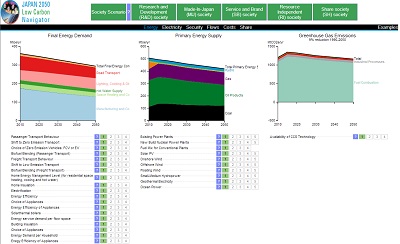News and Events
-
Japan 2050 Low Carbon Navigator Version 2 release! (March 2016)
Version 2 of the web tool of the Japan 2050 Low Carbon Navigator is now ready for use. The new version has a new summary page based on the 3E+S framework and other user-friendly functions.
-
International Conference
ITRI, UK DECC and IGES co-organise the International Conference on 2050 Calculator in Taipei -
The web tool of the Low Carbon Navigator was launched at the International Forum for Sustainable Asia and the Pacific (ISAP2014) on July 23-24 in Yokohama.
About Japan 2050 Low Carbon Navigator (Low Carbon Navigator)
Post-Fukushima Japan is now placed at the crossroads for deciding on its future energy policies through selecting the appropriate energy mix and low-carbon technologies to best ensure energy security while at the same time achieving the ambitious long-term target of an 80% reduction in greenhouse gases.
To help policymakers, energy producers and consumers (including the public) understand the energy and emission-related choices that Japan faces, the Institute for Global Environmental Strategies (IGES) and the National Institute for Environmental Studies (NIES) jointly developed the Japan 2050 Low Carbon Navigator (Low Carbon Navigator), a Japanese version of the UK 2050 Pathways Calculator. This work received valuable advice from many Japanese experts as well as technical assistance from the 2050 Pathways Calculator Team at the UK Department for Energy and Climate Change (DECC). The British Embassy Tokyo and the Ministry of the Environment of Japan provided support in various ways for the implementation and promotion of the project.
With a transparent dataset and user-friendly interface, the Low Carbon Navigator can be used as a handy tool for facilitating multi-stakeholder discussions on energy and climate polices, and for educating university students and the general public on how Japan can lock into a low-carbon pathway in the near future.
Low Carbon Navigator
-Using this tool for exploring low-carbon energy scenarios-
The Navigator is available in two versions, the web-tool version and the full Excel version, to allow a range of users to explore the fundamental question of how the Japan can best meet energy needs while reducing emissions.
Web Tool Version 2
Excel Spreadsheet
The full Excel version for those who want to look at the underpinning model. (4837KB)
- Guidance for Users (35KB)
Create your pathway
All the energy supply and demand sectors of the Japanese economy have been considered. For each choice of the sector, the Low Carbon Navigator sets out a range of four or five levels/trajectories for the types of changes that might occur. A combination of the sectoral options forms one pathway. Try out different ways of securing a low-carbon future for Japan by creating your own pathway using the 2050 Low Carbon Navigator Web Tool.
On the supply side you can choose how Japan produces its energy. For example, you can choose to keep the same level of renewable energy as of today in the energy mix or an ambitious scenario of up to 226 GW solar PV (16 times of today’s level) and 25 GW of onshore wind (8 times of today’s level) to be installed by 2050.
On the demand side you can choose whether to make your travel by car, by bus or by train. You can also select among different technologies of using ICE (internal combustion engine) cars, hybrid electric cars or all-electric vehicles.
For each choice four trajectories have been developed, ranging from little or no effort to reduce emissions to progressively higher efforts toward transition to a low-carbon society. For example, Level 1 represents low effort and continuation of existing capacity, technology and no change in consumption behaviour, whereas level 4 represents great effort leading towards increased use of renewable energy, advanced technology, and reduction of energy service demand. Level 5 in renewable energy sectors represents extremely ambitious changes that pushes towards the physical or technical limits of what can be achieved. The assumptions behind these trajectories are explained.
 Levels/trajectories setting
Levels/trajectories setting
You can explore some of the wider implications of your pathway by using the web-tool’s tabs. For example, you can see the implications of your pathway for the size of the electricity sector, you can visually track how energy flows through the system, and you can see how much your new energy system will cost to build. If you have any questions, please contact the Low Carbon Navigator Team.
Toolkit
Behind the Web Tool version of the Low Carbon Navigator is the dataset in the Excel version. This is a more complex model with open sources and entire transparency in displaying all of the supporting calculations and assumptions. We also prepared A User’s Guide to help you start up using the tool. The report on Overview and Trajectory Setting should help those looking for a more detailed understanding of each sectoral setting appeared in the Web Tool.
We held two expert meetings on 20 February 2014 and 16 April 2014 in Tokyo to review the Excel version of the tool. On 12 May 2014, we held a pre-launch workshop at the British Embassy Tokyo to invite academic experts, governmental officials and media to try out the tool.
IGES Research Report:
Japan 2050 Low Carbon Navigator: Overview and Trajectory Setting (1.5MB)

PPT (1.3MB)
Presentation at the pre-launch workshop on 12 May 2014





 Go to top of page
Go to top of page

